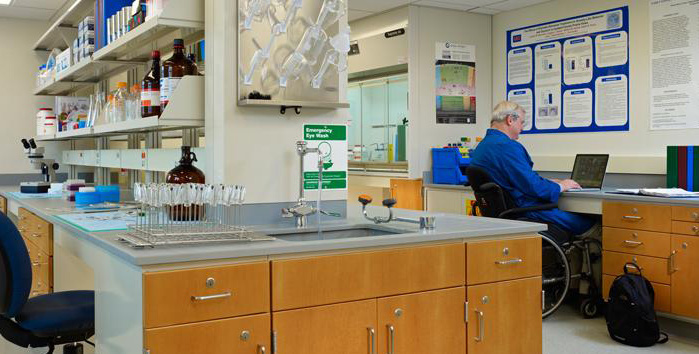Research Space for Behavior Neurobiology (RSBN) Lab Remodel

IMEG provided mechanical, electrical, fire protection, plumbing and technology engineering services for a 24,000-SF renovation on the second and third floors of an existing 11-story building.
The space houses animal research, human research, and chemical laboratories. Key elements of the research space include:
- revamped acoustical chamber
- microscopy lab
- freezer room that will house approximately 24 laboratory freezers with temperature monitoring and remote alarm capabilities
- autoclave room
- walk-in freezer room
- dark room
The project also includes a Computational Neurobiology section with a computer lab, server room and office space.
The biggest challenge of the design was the air handling system associated with the renovated spaces. The air handling unit serving the existing spaces was located in the mechanical penthouse, which sits above the 11th floor of the building, and a walk-in mechanical attic. Chemical and fume exhaust were routed up through the existing building and exhausted at the roof level to prevent re-entrainment in this or neighboring building’s outside air intakes.
The design, construction and budget were greatly affected by the fact that multiple exhaust duct risers needed to travel through approximately eight floors that would not be otherwise affected by this project. To create space for these risers, the design team opted to locate the new air handling unit on the renovated floors. This allowed the existing supply and return risers to be removed and the new exhaust risers to take their place.
Due to the nature of the research performed within the spaces, heavy emphasis was placed on vibration and acoustics. To reduce the vibration and noise generated by the central station air handling equipment, IMEG utilized fan wall technology, which consisted of nine small supply fans rather than one large supply fan. Furthermore, IMEG located sound attenuators on the manifolded return and exhaust ductwork directly upstream of the fans. Since airflow control and space pressurization were also critical factors in the design, IMEG utilized air valves to accurately control fume hood face velocities and space pressurization. While the accuracy of an air valve is far superior compared to similar devices, the noise generated can also be of concern. To remedy this, IMEG located sound attenuators between the air valves and inlets/outlets in acoustically sensitive spaces.
Other design obstacles included existing building utilities such as campus chilled water and emergency power. Building utilities were located in the basement and penthouse and were limited to existing equipment capacities. The new air handling equipment has larger fan motors than the existing equipment due to the higher airflows associated with laboratory spaces. Due to higher airflows and higher quantities of outside air, the capacity of steam and chilled water required to heat and cool the spaces also increased. One of IMEG’s largest tasks was to determine if these existing utilities could handle the increased loads associated with the new equipment and spaces. Emergency power availability was also an issue. The design team worked with the researchers to prioritize the equipment served by the emergency system.
Project planning included strategies to prevent other portions of the building from going down during construction of these spaces.







